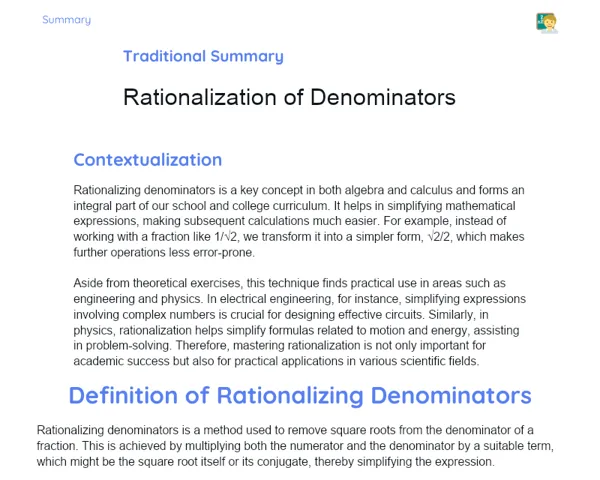Summary Tradisional | Arithmetic Progression: Terms
Contextualization
An Arithmetic Progression (A.P.) is a series of numbers in which the gap between successive numbers remains constant, and this gap is known as the common difference. This idea is a cornerstone in mathematics and finds its way into many everyday scenarios. For instance, when we witness the steady growth of a plant over a series of weeks or organise seating in an auditorium, we are essentially observing arithmetic progressions.
Apart from daily life instances, A.P. plays a significant role in areas such as construction, where it helps in planning the layout of bricks in a wall, and in economics for predicting population trends or returns on investment over time. Grasping how an Arithmetic Progression is structured and formulated not only aids in practical problem-solving but also supports sound decision-making in various fields.
To Remember!
Definition of Arithmetic Progression (A.P.)
An Arithmetic Progression (A.P.) is a series of numbers where the difference between each consecutive pair is constant. This fixed gap is the common difference. For example, in the sequence 2, 5, 8, 11,..., the constant gap is 3 since every consecutive pair of numbers differs by 3. An A.P. can be either finite, with a set number of terms, or infinite, continuing indefinitely. The key feature of an A.P. is that adding the common difference to any term gives the next term. This property makes it an effective tool for modelling situations that involve linear growth as well as a range of practical applications across various disciplines.
-
The difference between consecutive terms remains constant.
-
The common difference is this constant gap between successive terms.
-
An A.P. can be either finite or infinite.
General Term Formula of A.P.
The general term formula of an Arithmetic Progression is a vital tool for determining any term in the series without the need to list all the previous numbers. The formula is: aₙ = a₁ + (n - 1) × r, where aₙ represents the n-th term, a₁ is the first term, n indicates the term’s position in the sequence, and r is the common difference. For example, consider the A.P. 3, 7, 11, 15,... Here, a₁ is 3 and the common difference r is 4. To compute the 10th term, substitute into the formula: a₁₀ = 3 + (10 - 1) × 4 = 3 + 36 = 39. This formula proves extremely useful when solving problems that require finding the value or position of a term in a lengthy sequence.
-
The general term is given by aₙ = a₁ + (n - 1) × r.
-
It helps to compute any term directly without listing all preceding terms.
-
The first term and the common difference are the essential requirements for using this formula.
Practical Examples
Using practical examples clarifies how the theory of Arithmetic Progression applies to real-world problems. Consider the sequence 3, 7, 11, 15,... To find the 10th term, we apply the general term formula: a₁₀ = 3 + (10 - 1) × 4 = 39. Hence, the 10th term is 39. Similarly, for the sequence 2, 5, 8, 11,... where the common difference is 3, using the formula a₅ = 2 + (5 - 1) × 3 results in 2 + 12 = 14. Thus, the 5th term is 14. These examples demonstrate how the general formula for an A.P. can be effectively used to deduce specific terms and predict values.
-
Examples clearly illustrate the practical application of the theory.
-
The general formula is used to compute specific terms in the sequence.
-
They offer a good understanding of how A.P. operates in real-life situations.
Identifying Terms
Being able to pinpoint specific terms in an Arithmetic Progression is a crucial skill in mathematics. For instance, in the sequence 2, 5, 8, 11,... to determine the 7th term, we use the formula: a₇ = 2 + (7 - 1) × 3 = 20. Moreover, you can also determine the position of a given term. For example, if we know that 20 is part of the A.P. 2, 5, 8,... and wish to find its position, we can rearrange the formula: n = ((aₙ - a₁) / r) + 1. Plugging in the values: n = ((20 - 2) / 3) + 1 = 7, which shows that 20 is the 7th term. This ability is essential for solving both theoretical and practical problems that involve arithmetic sequences.
-
Identify specific terms using the general term formula.
-
Determine the position of any term in the sequence.
-
This is essential for addressing both practical and theoretical problems.
Key Terms
-
Arithmetic Progression (A.P.): A series of numbers with a constant gap between consecutive ones.
-
Common Difference: The fixed gap between consecutive terms in an A.P.
-
General Term: The formula used to calculate any term in an A.P.
-
Numerical Sequence: An ordered set of numbers that follow a specific rule.
Important Conclusions
In this lesson, we explored the concept of an Arithmetic Progression (A.P.), a numerical sequence where each consecutive term differs by a constant, known as the common difference. We discussed its definition, derived the general term formula, and demonstrated its utility in calculating any term without listing the entire sequence. Moreover, practical examples illustrated how this concept can be applied in everyday problems, such as computing specific terms and identifying their positions in a sequence.
The understanding of Arithmetic Progression is fundamental not only in mathematics but also in diverse practical fields like construction and economics. Mastery in computing and identifying terms in an A.P. is a skill that enhances problem-solving and supports informed decision-making across various disciplines. Throughout the lesson, we've built both theoretical knowledge and practical skills regarding arithmetic sequences.
We encourage students to delve deeper into the topic, practice problem-solving, and explore further applications of A.P. in everyday life. Consistent practice and a curious mindset are key to gaining proficiency with this important mathematical tool.
Study Tips
-
Revisit the general term formula for A.P. and solve different problems to strengthen your understanding.
-
Try to spot examples of Arithmetic Progressions in your daily life and create your own problems.
-
Practice additional exercises on Arithmetic Progressions from textbooks and online resources to consolidate your learning.



